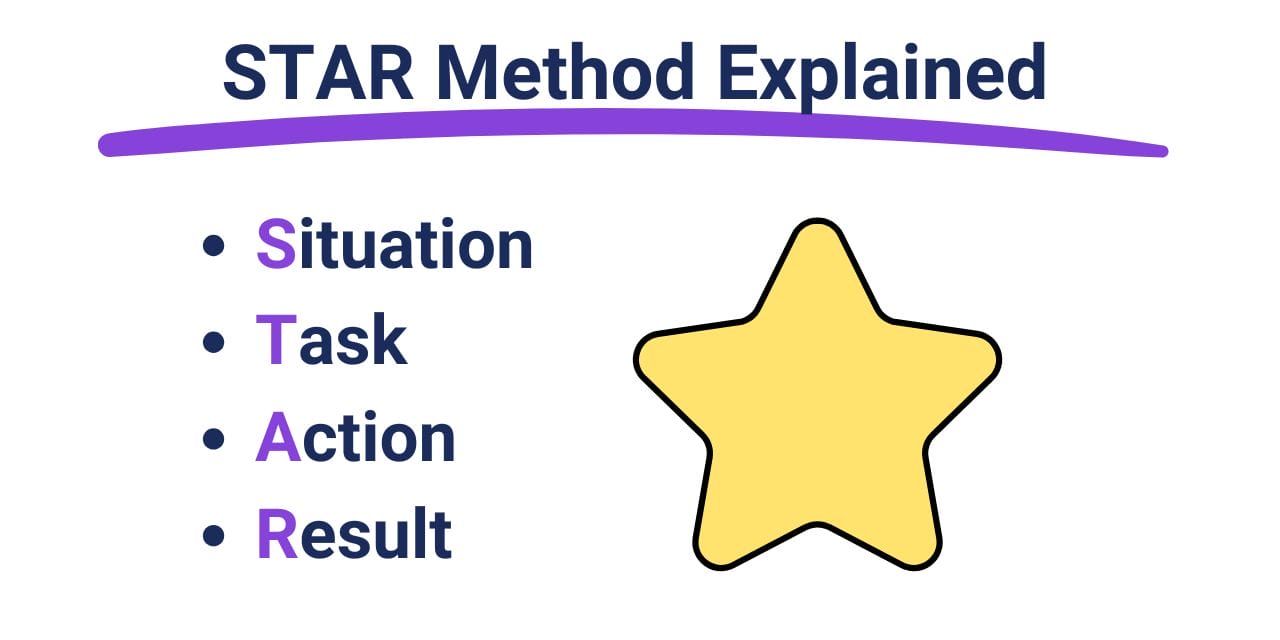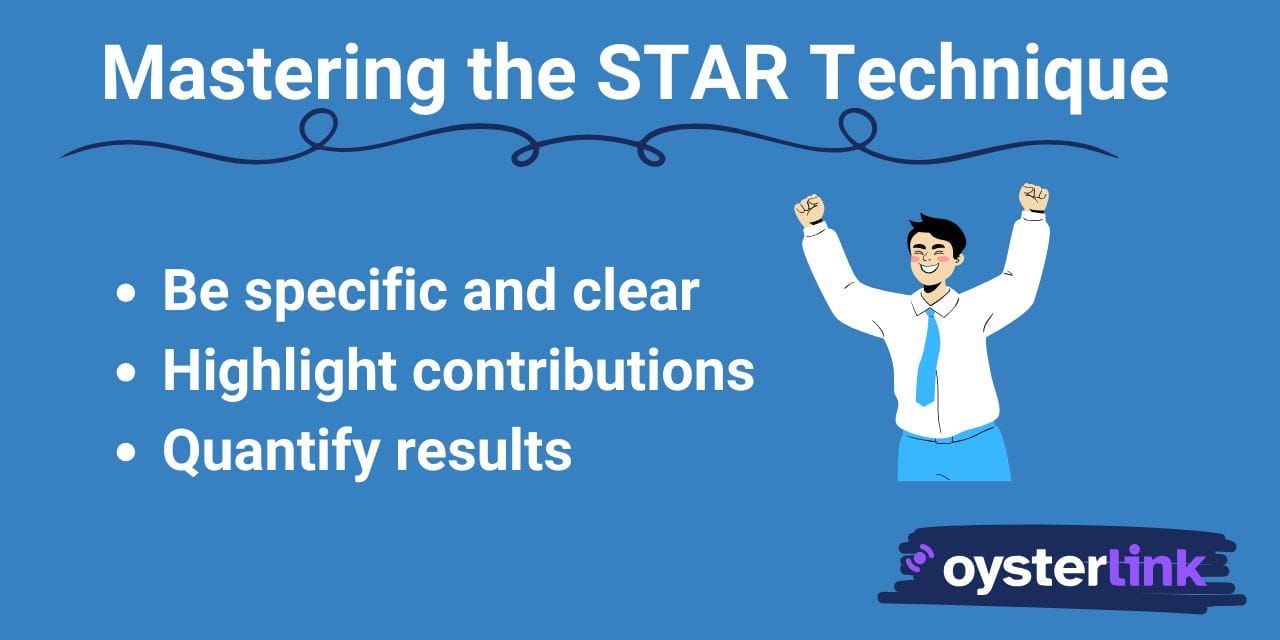This comprehensive guide will walk you through the ins and outs of the STAR method approach, allowing you to stand out and shine during your next interview.
Understanding the Star Method
The STAR method is a technique designed to help job seekers provide concise and relevant responses to behavioral interview questions. This approach enables candidates to showcase their skills and experiences through specific examples, giving interviewers a clear picture of their capabilities.
What does STAR stand for?
STAR is an acronym that breaks down into four key components:
- Situation: Set the scene and provide context for your example.
- Task: Explain the responsibility or challenge you faced.
- Action: Describe the steps you took to address the situation.
- Result: Share the outcomes of your actions and what you learned.
Following this structure, you can craft compelling stories demonstrating your problem-solving abilities and professional growth.
Why employers use the STAR method
Hiring managers and recruiters favor the STAR method because it allows them to assess a candidate's past performance as an indicator of future success. This approach:
- Provides concrete examples of skills in action
- Reveals a candidate's decision-making process
- Demonstrates the ability to handle real-world challenges
- Offers insights into a candidate's self-awareness and reflection skills

For employers, these behavioral questions and structured responses offer a more reliable way to evaluate potential hires compared to hypothetical scenarios or general queries.
Preparing for STAR Method Interviews
Success with the STAR method requires thoughtful preparation. Here's how to get ready:
Analyzing the job description
Start by thoroughly reviewing the job posting. Identify key skills and qualities the employer is seeking. This will help you anticipate potential questions and prepare relevant examples from your experience.
You can find useful job descriptions for most hospitality positions on OysterLink’s job description page. By analyzing job descriptions, you’ll be able to understand what employers are looking for much more clearly.
Crafting your star stories
Develop a repertoire of anecdotes that highlight your strengths. Consider experiences from various aspects of your life — work, education, volunteering or personal projects. Aim for a mix of stories that showcase different skills and situations.
Practicing your responses
Rehearse your STAR responses out loud. This will help you refine your delivery and ensure you can articulate your experiences clearly and concisely. Consider asking a friend or mentor to conduct a mock interview and provide feedback.
Get comfortable being interviewed by a family member or a friend and practice as much as you have to. It’s okay to be nervous during the actual interview, but you’ll feel much more prepared and less anxious if you’ve already practiced a mock interview at home.
Implementing the Star Method During Interviews
When faced with a behavioral question in an interview, here's how to structure your response using the STAR method.
Setting the scene (situation)
Begin by briefly describing the context of your example. Provide enough detail for the interviewer to understand the circumstances, but avoid unnecessary information. For instance:
"In my previous role as a Line Cook at a busy downtown restaurant, we unexpectedly lost two staff members during our peak summer season."
Defining your role (task)
Clearly state what was expected of you or what challenge you needed to address. This helps the interviewer understand your specific responsibilities. For example:
"As the senior Line Cook, I was tasked with maintaining our high-quality standards and efficient service while we were short-staffed."
Detailing your actions
This is the meat of your response. Explain the steps you took to handle the situation, focusing on your individual contributions. Use "I" statements to highlight your personal role:
"I immediately reorganized our kitchen workflow, cross-trained the remaining staff on multiple stations and worked closely with the Chef to streamline our menu temporarily. Additionally, I put in extra hours to ensure all prep work was completed before service began."
Sharing the outcome (result)
Conclude by describing the positive results of your actions. Whenever possible, use specific metrics or feedback to quantify your success:
"Thanks to these efforts, we maintained our usual service times and received no customer complaints despite being short-staffed. The Chef commended our team's adaptability and we even saw a 5% increase in positive online reviews during that period."
Common STAR Interview Questions and Sample Answers
Preparing for interviews using the STAR method involves practicing responses to typical behavioral questions. Here are some examples:
"Describe a time when you faced a challenging situation at work. How did you handle it?"
- Situation: In my previous role as a project coordinator, we encountered an unexpected delay from a key supplier, jeopardizing our project deadline.
- Task: I needed to find an alternative solution to prevent the project from falling behind schedule.
- Action: I researched and contacted several other suppliers, negotiated expedited delivery terms, and coordinated with the team to adjust our workflow.
- Result: We secured a new supplier who delivered on time, allowing us to complete the project as scheduled and maintain client satisfaction.
"Give an example of a goal you set and how you achieved it."
- Situation: As a sales representative, I was tasked with increasing our client base in a competitive market.
- Task: My goal was to onboard 15 new clients within the quarter.
- Action: I developed a targeted outreach strategy, personalized pitches, and followed up diligently with prospects.
- Result: By the end of the quarter, I successfully signed 20 new clients, exceeding my goal by 33%.
For each of these, think of relevant experiences and structure your responses using the STAR format. If you need more inspiration, especially for a specific hospitality role, you can find them on our interview questions page.
Tips For Mastering the Star Method
To truly excel in STAR method interviews, here are some additional things you should keep in mind:
- Be Specific: Provide detailed examples to give a clear picture of your actions and outcomes.
- Quantify Results: Whenever possible, use numbers to demonstrate the impact of your actions.
- Practice Aloud: Rehearse your STAR responses to ensure clarity and confidence during delivery.
- Tailor Examples: Choose scenarios relevant to the job you're applying for to highlight pertinent skills.
Be specific and concise
While it's important to provide context, avoid getting bogged down in unnecessary details. Aim to keep your entire response to two minutes or less. Remember that even though you want to showcase your skills, you don’t want to bother the Hiring Manager with unrelated details since they have other candidates to go through.
Quantify results when possible
Numbers and metrics can make your achievements more tangible. Whether it's a percentage improvement, dollar amount saved or number of people impacted, quantifiable results add weight to your story. It’s much more powerful to say “I reduced prep times by 2 minutes” rather than stating something generic like “I helped speed up prep times.”

Practice active listening
Pay close attention to the interviewer's questions. Make sure you're addressing exactly what they're asking and tailor your STAR examples accordingly. This is a good example of listening and answering rather than just shouting out already-prepared statements.
Have a variety of examples ready
Prepare stories that showcase different skills and situations. This will allow you to adapt to various questions and demonstrate the breadth of your experience. For example, if you worked as a Bartender, explain how you dealt with a rude or drunk customer.
Adapting the Star Method for Different Industries
While the STAR method is universally applicable, you may need to tailor your approach based on your industry. Here's how you can do that.
For hospitality professionals
Focus on examples that highlight customer service skills, ability to work under pressure and teamwork. A Bartender might share a story about diffusing a tense situation with a difficult patron, while a Hotel Manager could discuss implementing a new guest satisfaction initiative.
In tech and IT
Emphasize problem-solving abilities, technical skills and adaptability to new technologies. A Software Engineer could describe a time they debugged a critical system issue, detailing the technical steps taken and the impact on the company's operations.
For healthcare workers
Highlight instances of patient care, ethical decision-making and working in high-stress environments. A Nurse might recount an experience of managing multiple critical patients during a staff shortage, emphasizing both technical skills and empathy.
Applying the STAR Method Beyond Interviews
The STAR method isn't just useful for interviews — it can be a valuable tool throughout your career. In performance reviews, using the STAR format to document your achievements throughout the year makes it easier to discuss your contributions and value during evaluations. For instance, detailing a situation where you improved a process, the tasks you undertook, the actions implemented, and the resulting efficiency gains can provide concrete evidence of your impact.
- In performance reviews: Use the STAR format to document your achievements throughout the year. This makes it easier to discuss your contributions and value during performance evaluations.
- For resume writing: When crafting bullet points for your resume, structure them using the STAR method to provide concrete examples of your accomplishments.
- In networking situations: Having STAR stories ready can help you make a strong impression when meeting new professional contacts. These anecdotes serve as compelling illustrations of your skills and experiences.
Common Pitfalls To Avoid
While the STAR method is powerful, there are some common mistakes to watch out for:
Fabricating or exaggerating stories
Always stick to true experiences. Embellishing or inventing stories can backfire if an interviewer asks for more details or checks your references. Remember that it’s much better to be honest than be caught in a lie, even if you don’t have a super-impressive resume.
Focusing too much on the situation
While context is important, the bulk of your response should be about your actions and the results. Don't get bogged down in setting the scene. The entire goal of the STAR method is to give some context while still showcasing your skills, talent and experience.
Neglecting the result
The outcome is crucial since it demonstrates the impact of your actions. Always conclude with clear results, even if they weren't entirely positive (in which case, focus on what you learned). If you can turn a negative experience into a good one with the lesson you learned along the way, employers will appreciate your critical thinking and the ability to take feedback.
Using the same example repeatedly
Relying on a single story for multiple questions can make you appear one-dimensional. Have a diverse set of examples ready to showcase different skills and experiences. They don’t have to be in different roles or in different companies, but just different stories that helped you grow and learn.
Using the STAR Method in Interviews
Mastering the STAR method can significantly enhance your interview performance and overall career development. By preparing thoughtful, structured responses to behavioral questions, you'll be better equipped to showcase your skills and experiences effectively. Remember, practice is key. The more you work with this technique and practice it, the more natural and impactful your responses will become. With the STAR method in your toolkit, you'll be well-prepared during your next interview.












Loading comments...